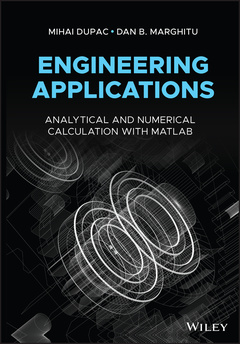Engineering Applications Analytical and Numerical Calculation with MATLAB
Auteurs : Dupac Mihai, Marghitu Dan B.

A comprehensive text on the fundamental principles of mechanical engineering
Engineering Applications presents the fundamental principles and applications of the statics and mechanics of materials in complex mechanical systems design. Using MATLAB to help solve problems with numerical and analytical calculations, authors and noted experts on the topic Mihai Dupac and Dan B. Marghitu offer an understanding of the static behaviour of engineering structures and components while considering the mechanics of materials knowledge as the most important part of their design.
The authors explore the concepts, derivations, and interpretations of general principles and discuss the creation of mathematical models and the formulation of mathematical equations. This practical text also highlights the solutions of problems solved analytically and numerically using MATLAB. The figures generated with MATLAB reinforce visual learning for students and professionals as they study the programs. This important text:
Written for students and professional mechanical engineers, Engineering Applications helpshone reasoning skills in order to interpret data and generate mathematical equations, offering different methods of solving them for evaluating and designing engineering systems.
1 Forces 1
1.1 Terminology and Notation 1
1.2 Resolution of Forces 3
1.3 Angle Between Two Forces 3
1.4 Force Vector 4
1.5 Scalar (Dot) Product of Two Forces 5
1.6 Cross Product of Two Forces 5
1.7 Examples 6
2 Moments and Couples 15
2.1 Types of Moments 15
2.2 Moment of a Force About a Point 15
2.3 Moment of a Force About a Line 18
2.4 Couples 20
2.5 Examples 21
3 Equilibrium of Structures 55
3.1 Equilibrium Equations 55
3.2 Supports 57
3.3 Free-Body Diagrams 59
3.4 Two-Force and Three-Force Members 60
3.5 Plane Trusses 61
3.6 Analysis of Simple Trusses 62
3.6.1 Method of Joints 62
3.6.2 Method of Sections 65
3.7 Examples 67
4 Centroids and Moments of Inertia 129
4.1 Centre of the Mass and Centroid 129
4.2 Centroid and Centre of the Mass of a Solid Region, Surface or Curve 130
4.3 Method of Decomposition 134
4.4 First Moment of an Area 134
4.5 The Centre of Gravity 135
4.6 Examples 136
5 Stress, Strain and Deflection 185
5.1 Stress 185
5.2 Elastic Strain 185
5.3 Shear and Moment 186
5.4 Deflections of Beams 189
5.5 Examples 193
6 Friction 211
6.1 Coefficient of Static Friction 212
6.2 Coefficient of Kinetic Friction 213
6.3 Friction Models 213
6.3.1 Coulomb Friction Model 214
6.3.2 Coulomb Model with Viscous Friction 216
6.3.3 Coulomb Model with Stiction 217
6.4 Angle of Friction 218
6.5 Examples 219
7 Work, Energy and Power 255
7.1 Work 255
7.2 Kinetic Energy 256
7.3 Work and Power 258
7.4 Conservative Forces 259
7.5 Work Done by the Gravitational Force 259
7.6 Work Done by the Friction Force 260
7.7 Potential Energy and Conservation of Energy 261
7.8 Work Done and Potential Energy of an Elastic Force 261
7.9 Potential Energy Due to the Gravitational Force 262
7.9.1 Potential Energy Due to the Gravitational Force for a Particle 262
7.9.2 Potential Energy Due to the Gravitational Force for a Rigid Body 263
7.10 Examples 264
8 Simple Machines 295
8.1 Load and Effort, Mechanical Advantage, Velocity Ratio and Efficiency of a Simple Machine 295
8.1.1 Load and Effort 295
8.1.2 Mechanical Advantage 296
8.1.3 Velocity Ratio and Efficiency 296
8.2 Effort and Load of an Ideal Machine 297
8.3 The Lever 297
8.4 Inclined Plane (Wedge) 298
8.5 Screws 299
8.6 Simple Screwjack 299
8.6.1 Motion Impending Upwards 301
8.6.2 Motion Impending Downwards 302
8.6.3 Efficiency While Hoisting Load 303
8.7 Differential Screwjack 303
8.8 Pulleys 304
8.8.1 First-order Pulley System 304
8.8.2 Second-order Pulley System 306
8.8.3 Third-order Pulley System 307
8.9 Differential Pulley 308
8.10 Wheel and Axle 309
8.11 Wheel and Differential Axle 310
8.12 Examples 312
References 353
Index 357
Mihai Dupac, PhD is a Senior Lecturer in Engineering Design at Bournemouth University, UK. He serves as the principal investigator and/or co-investigator for several research projects related to biomechanics and engineering design.
Dan B. Marghitu, PhD is a Professor at Auburn University and the Director of the Impact Dynamics Laboratory, which focuses on the investigation of relevant problems associated with impact dynamics, friction, and locomotion.
Date de parution : 03-2021
Ouvrage de 368 p.
17x24.4 cm



